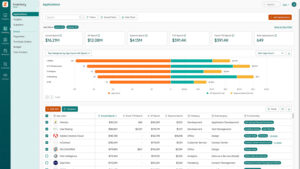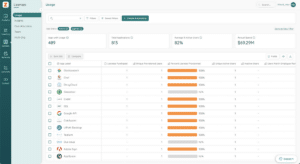05/25/2021
Table of Contents
The explosive rise of software-as-a-service (SaaS) in recent years changes the way IT leaders must approach IT vendor management. In fact, more than 70% of organizations now exclusively use SaaS applications over traditional on-premises software.
The flexibility of obtaining cloud-based SaaS applications with the click of a mouse makes it easy for individual employees to acquire new tools—so easy that business units and employees combined now control more SaaS spending and manage more SaaS inventory than centralized IT teams.
To properly manage SaaS applications and vendors, many organizations employ IT vendor management best practices.
What Is IT Vendor Management?
In the age of SaaS, IT vendor management involves effectively monitoring an ever-growing roster of SaaS vendors to:
- Control costs
- Minimize shadow IT
- Ensure compliance with privacy and security protocols, leverage software agreements and partnerships
- Manage contracts and SaaS renewals
Traditionally, IT vendor managers oversaw the sourcing, procurement, and overall management of a handful of on-premise software applications.
The decentralization of SaaS acquisition not only means more individuals purchase software unbeknownst to IT, it can push the overall number of software applications for a business into the hundreds or even thousands. Zylo research shows large enterprises now employ an average of 660 SaaS applications, and many drastically underestimate the number by nearly 2X.

The challenge for most organizations becomes tracking decentralized vendor management, while enabling the right level of visibility and control.
Proper visibility allows your organization to consolidate subscriptions, eliminate underused licenses, plan for renewals, and perform cost-effective negotiations—all of which reduce spend, as well as enhance budgeting and forecasting.
In today’s modern cloud and SaaS environments, effective IT vendor management needs to occur across the entire organization, including every department and team.
How to Implement IT Vendor Management Best Practices
The key to successful SaaS vendor management involves regular discovery, governance and contract management, analyzing usage and entitlements, and maintaining open lines of communication with SaaS vendors.
As you begin, consider the following IT vendor management best practices:
#1 Discover All SaaS Applications
First, discover all of your organization’s SaaS tools and applications to establish a complete IT vendor portfolio. Take note of the types of tools, usage, and most importantly—who is buying it.
 Zylo data shows about one in every fifteen employees purchase SaaS licenses with a company credit card and request expense reimbursement. Decentralized purchases increase the risk of redundant, underutilized, and duplicate software. It also makes discovery more challenging.
Zylo data shows about one in every fifteen employees purchase SaaS licenses with a company credit card and request expense reimbursement. Decentralized purchases increase the risk of redundant, underutilized, and duplicate software. It also makes discovery more challenging.
If your organization tracks SaaS vendors using a spreadsheet or other manual processes, consider using Zylo’s Discovery Engine, which applies machine learning to unearth all of an organization’s applications for full discovery with close to 100-percent accuracy.
#2 Maintain a Centralized System of Record
To effectively implement IT vendor management best practices, you need to maintain a centralized system of record for key contract and agreement details. Important details to track include:
- Length of contracts: Knowing the start and end dates helps to prevent unnecessary automatic renewals.
- Renewal notification timelines: Make sure to allot enough time so you can assess whether or not to continue working with a SaaS vendor.
- Preferred notification method: Understand how each vendor handles renewals—emails, calls, in-app notifications, etc.
- Important license details: Know the license quantities, entitlements, and other line-item details to ensure you get the most out of each license and application.
The ability to quickly locate vendor agreements and SaaS requirements gives your organization leverage when it comes time to negotiate, renew, or cancel. Consider storing all of your licensing details in a centralized SaaS management database, such as Zylo.

#3 Analyze Entitlements and Usage
Before you decide to provision or deprovision a license, compare user entitlements with application activity data on adoption and utilization to see the full picture.
Consider Zoom, for example. Zylo’s direct integration into Zoom allows you to compare average minutes of meeting per user and number of active licenses.
Zoom requires a premium license for any meeting that exceeds 40 minutes with more than two attendees. If employees typically only use Zoom for quick meetings, consider downgrading paid licenses to free licenses.
The same goes for your entire SaaS vendor inventory: Why pay for unused or underutilized premium entitlements?

#4 Communicate Early with Vendors
Follow IT vendor management best practices by communicating early with vendors, especially when you need to negotiate a better deal but retain the service.
Typically, many organizations scramble when an application comes up for automatic renewal, not knowing the number of employees who use an application or how frequently. It often results in renewing an application you no longer use or need.
Zylo’s SaaS Management platform, including a dedicated renewal calendar, provides ample notification of upcoming renewals. Contract and usage data gives you fuel when you need to negotiate better terms or features.

Create an IT Vendor Management Framework
Create an IT vendor management framework to ensure your entire organization—not just your IT team—follows IT vendor management best practices.
An IT vendor management framework must be flexible to account for decentralized SaaS vendor management. With the shift to product-led growth (PLG), software makers successfully target individuals and teams, instead of IT departments.
One way to approach building an IT vendor management framework involves considering the point of view of the IT vendor’s lifecycle within your organization.
Just make sure to standardize processes at key checkpoints in the SaaS management lifecycle—to more readily apply best practices at the right time and ensure proper IT vendor management governance.
Implement a Pre-Purchase Review Process
The best way to limit problems related to SaaS involves establishing a process for reviewing and standardizing purchases far in advance.
A pre-purchase review and approval process empowers the organization to:
- Preserve value by cross-checking for functionally similar alternatives, including existing software and new vendors.
- Vet for compliance to standards and policies concerning cybersecurity, compliance for data and privacy standards, legal compliance, and financial accountability.
- Approve or reject purchases based on your predetermined objective criteria.
Develop an Onboarding Plan
A clear-cut onboarding plan details how a new SaaS tool enters the organization and outlines application ownership, stakeholder roles, and benchmarks to determine application value and usage.
Manage SaaS Applications
Managing SaaS applications remains a continual but critical task within the IT vendor management framework. Maintain an accurate system of record to track ownership, utilization, contract lengths, and renewal dates. Perform ongoing discovery of new and existing applications every 30 days to ensure IT vendor management governance.
Plan for Renewals
Create a renewal plan to give your organization ample time to examine metrics and communicate with stakeholders before renewal. It also provides an opportunity to negotiate with vendors, especially if you need to rightsize a license or broker better terms. Planning proactively for renewals enables data-driven decision-making.
Follow an Off-boarding Plan
Create and follow an off-boarding plan to ensure continuity, prevent data loss, mitigate security risk, and monitor for shadow IT.
The bottom line: Following an IT vendor management framework ensures everyone in your organization follows best practices in the age of SaaS management, which in turn boosts efficiency, saves money, and fuels growth.
Ready to discover how Zylo can optimize IT vendor management? Reach out to request a personalized demo of Zylo today.
ABOUT THE AUTHOR

Zylo
Zylo is the leading enterprise SaaS management platform that transforms how companies manage and optimize the vast and accelerating number of cloud-based applications organizations rely on today. The platform provides one system of record for all cloud-based software purchased across a company, enabling customers to discover, manage, measure and optimize cloud investments with real-time insights into spend, utilization and feedback data.

